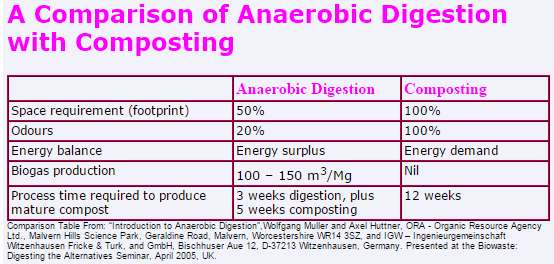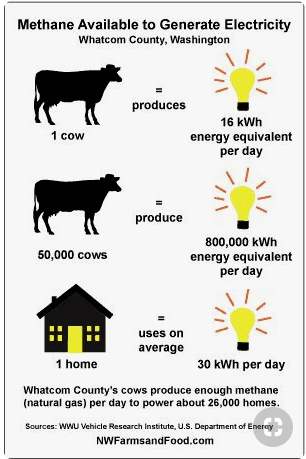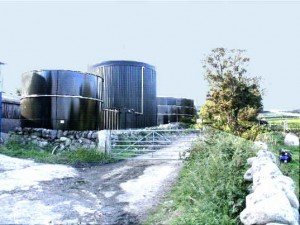
Anaerobic Digestion Basics
When we titled this page Anaerobic Digestion Basics we decided to include all the basic information someone new to Anaerobic Digestion would be looking for. We start with a definition of the AD process and provide a menu of links to the other basic AD process concepts. If you scroll down further you will see additional background information about anaerobic digestion, which we thought our readers would find useful to learn a basic understanding of the AD process.
Definition:
Anaerobic digestion (AD) is a biological process similar in many ways to composting, but without air. It is a natural treatment process and, as in composting, bacteria break down organic matter and reduce its bulk or “mass”. Its huge advantage is that it produces a gas called biogas which is 50% to 75% methane, and that's a clean-burning gas with huge potential for reducing carbon dioxide emissions.
Anaerobic Digestion Basics: Contents
Technical:
What is Anaerobic Digestion?
What is Digestate?
Small-Scale Anaerobic Digestion for Homes and Communities
Anaerobic Sludge Digestion Explained
Anaerobic Digestion of Food Waste
Financial (UK Government Financial Assistance for Anaerobic Digestion):
UK Biogas Funding for Biofuels and CHP
UK Feed-in Tariffs for Small-Scale Electricity Generation Including Small Biogas Plants
To gain an initial and rapid introduction to the basic concept of the modern anaerobic digestion plant (also known as a Biogas Plant, we recommend that you watch the video below. In under 3 minutes, you will know a lot more about what happens in a basic biogas plant:

Watch the next video if you would like to see an introduction to “state-of-the-art” Anaerobic Digestion (at a Dairy Farm). Learn how the basic anaerobic digestion process is enhanced by adding further processing. This provides additional products and income. Doing this can greatly increase the financial viability of on-farm anaerobic digestion (biogas) plant projects.
A Comparison of Anaerobic Digestion with Composting
Part of understanding the anaerobic digestion basics is an appreciation of the differences between anaerobic digestion and composting.
Unlike composting AD is carried out in an oxygen-free environment (known as anaerobic conditions) to allow the presence of bacteria adjusted to these conditions which then multiply and grow, and by so doing achieve the process aims of:
- sanitisation of the feed material and of any liquid discharged;
- a net positive surplus generation of energy as a biofuel to allow power production from methane gas (biogas) produced by the organisms.
Photo at top of page: A Greenfinch Anaerobic Digestion Plant which was built during 2004/5 for use on a farm.
 Why are we excited about Anaerobic Digestion (AD) just now?
Why are we excited about Anaerobic Digestion (AD) just now?
Here are 7 reasons for the current high rate of growth in anaerobic digestion facilities in particular (also known as “Biogas Plants”) in the industrialized nations, and the UK:
- Farm waste requires better management: As of 2006, the EU Waste Management rules have been applied to farming and agriculture. The historical exemption of farming from compliance with waste disposal regulations having been removed. This is in some instances encouraging uptake of anaerobic digestion as an on-farm waste disposal method.
- Farms Must Now Store Slurry to Prevent Run-off Causing Pollution: New regulations were implemented in 2012 and avoid its discharge, and this often requires a provision for 6 months of storage. Rather than invest in tanks of this size, farmers can treat their slurry by AD and gain an income from the biogas, while at the same time reducing their slurry lagoon (or tank) storage requirements.
- Organic waste must be diverted from landfill: This is the result of the EU Landfill Directive and AD is an excellent technology for organic waste landfill diversion.
- There is a demand for new sustainable technologies and investment opportunities often powered by individuals, but increasingly manifested in actions and investments by large companies and

An Early Greenfinch Anaerobic Digestion Plant On-farm big investors. They are looking for “green” investments enabling their organisation to show social responsibility, and are an outcome of the push toward large corporations becoming more sustainable. (May 2012: Update – For example, in the UK a number of the major supermarkets are starting to use renewable energy technology in their stores, including operating anaerobic digestion plants to digest their own food waste and provide power to run their stores.)
- Rising demand for renewable fuels and bioenergy: This includes government targets and incentives to anaerobic digestion which the United Kingdom and other governments provide to help them meet their committed targets.
- The availability of Carbon Credits (in developing nations): to those who avoid Carbon Dioxide emissions and apply Carbon Discharge Management (CDM): The developing world has been able to apply and obtain Carbon Emissions Reduction (CER) credits where they achieve carbon emissions reductions, and such reductions are achieved very effectively by installing an anaerobic digestion plant with biogas production and also using the waste heat to provide hot water to be used heating homes, or in factories.
- Easier planning permission: In the spring of 2012 the UK government also relaxed planning permission requirements for anaerobic digestion plants on farms, below a certain size.
- Rising oil prices: Suddenly traditional energy sources are so much more expensive. In the past AD was a much more expensive energy source, and to be honest it remains so when all capital spend up-front is considered unless governments provide financial incentives. But, even in nations where incentives are absent the gap is narrowing toward mainstream take-up of AD.
The above 8 points are the anaerobic digestion basics driving biogas plant development.
Anaerobic Digestion Flow Diagram
A simple process flow diagram showing the paths of the main materials and outputs is shown below:

8 Main Source Materials for Anaerobic Digestion (Temperate Climates)
- Food/ catering waste from private households
- Food residues from food processing
- Restaurant and canteen residues
- Farm manure (e.g. liquid manure, dung)
- Vegetable residues on-farm, and from commerce and trade
- Waste water from food production
- Grease trap fat – Fats Oils, and Greases (FOG)
- Specially grown organic materials – biofuel food crops (e.g. maize, silage, clover). See also our bigger list here.
Products of Anaerobic Digestion
- A gas: Largely methane – a fuel.
- Solid fibrous material (“digestate”); that is spread without further treatment, or after post composting (maturation), to provide organic matter for improvement of soil quality and fertility (improves soil structure and reduces summer irrigation demand).
- The liquid fraction; contains two-thirds of the nutrients and can be spread as a fertiliser and sprayed on crops. Where co-composting on farms the liquid and solid fraction may not be separated and the digestate is spread as a slurry.
If you know of more reasons for growth in biogas production or would like to add to our list of “anaerobic digestion basics” source materials, we would like to hear from you. Please use our comments form below to add your reasons for the rising number of Anaerobic Digestion facilities.





Interesting and vital useful info on biogas.
Still, to me in order to make a really interesting blog, you need not only to inform about something, but do it in an interesting way :).
Some parts are good but others I find hard to understand the meaning. you should make more simple to read.
I will be making time to learn about your anaerobic digestion subjects and keep track of new improvements inside the scientific research of dealing with carbon usage reductions.
I was thinking I don’t know what to do as I have a lot of of work to do next semester. Will be using quite a bit of your ideas from this website. Hopefully it will all go well. Wish me luck.
The most basic AD facilities are. small-scale biogas reactors which are typically designed to produce biogas at the household or community level in rural areas.
Your pages I like. I am suggesting that at present, over a million biogas plants already exist in China. We made the finding that they meet more than 80% of the heat demand of the rural localities where they are located. Germany has over the last 20 years produced no more than the region of 5,000 biogas production plants. UK even less than Germany. Do you know what I am saying? You can go to the Chinese who do the best at having knowledge on the basis of biogas making. That is my thought.